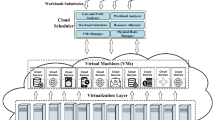Abstract
Cloud computing is a facility that provides access to services. Management of massive amount of information in cloud computing is achieved by using VM consolidation. Nowadays, power or energy saving has emerge as a key factor in designing VM consolidation algorithms. Algorithms for deciding on next VM have never given consideration to both strength and data at the identical time in past. Cloud provides virtual access to resources. The users have a policy model to pay based on usage. The facility provides restrictions on access with increased time delays. A hypervisor with optimized algorithm approach will allow for allocation to resources in a optimal manner. This paper proposes a novel hypervisor named Cloud Resource Scheduling Optimal Hypervisor (CRSOH) for Dynamic Cloud Computing. Surroundings for deciding on VM with energy and facts constraints. Proposed algorithm within the direction of most resource utilization with the aid of VMs. Proper utilization of sources ends in conservation of energy. As a result, energy intake using CRSOH algorithm is much less and more efficient than other present algorithms.













Similar content being viewed by others
References
Puneet, H. (2017). Efficient technique for allocation of processing elements to virtual machines in cloud environment. International Journal of Computer Science and Network Security, 16(8).
Patel, J., & Prajapathi, J. (2017). A Survey scheduling algorithms and types of resources provisioning in cloud environment. International Journal of Engineering and Computer Science, 4(1), 10132–10134. (ISSN: 2319–7242).
Dorian, M., Freisleben, B. (2011). Utility-based resource allocation for virtual machines in cloud computing. Computers And Communications (Iscc), 2011 Ieee Symposium On. Ieee.
Ramadhan, G., Purboyo, T. W., & Latuconsina, R. (2018). Experimental model for load balancing in cloud computing using throttled algorithm. International Journal of Applied Engineering Research, 13(2), 1139–1143. (ISSN 0973-4562).
Mistra, M., Das, A., Kulkarni, P., Sahoo, A. (2012) Dynamic resource management using virtual machine migrations. Sep 2012, 0163–6804/12, Sep 2012, 0163–6804/12, IEEE Communications Magazine, pp: 34–40.
Lucas-Simarro, J.L., Vozmediano, R.M., Montero, R.S., Llorente, I.M. (2012) Scheduling strategies for optimal service deployment across multiple clouds. Future Generation Computer Systems, SciVerse ScienceDirect.
Liu, H., Abraham, A., Snanel, V., & McLoone, S. (2012). Swarm scheduling approaches for work-flow applications with security constraints in distributed data-intensive computing environments. Information Sciences, 192, 228–243.
Lee, Y. C., Wang, C., Zomaya, A. Y., & Zhoua, B. B. (2012). Profit driven scheduling for cloud services with data access awareness. Journal of Parallel Distributed Computer, Science Direct, 72, 591–602.
Nathani, A., Chaudharya, S., & Somani, G. (2012). Policy based resource allocation in IaaS cloud. Future Generation Computer Systems, 28, 94–103. https://doi.org/10.1016/j.future.2011.05.016.
Huaa, Z.Y., Leia, F., Zhia, Y. (2011). Optimization of cloud database route scheduling based on combination of genetic algorithm and ant colony algorithm. In procedia engineering 15, Published by Elsevier Ltd., pp. 3341–3345.
Baomin, Xu, Zhao, C., Hua, E., & Bin, Hu. (2011). Job scheduling algorithm based on Berger model in cloud environment. ScienceDirect, Advances in Engineering Software, 42, 419–425.
Jung, G., Sim, K.M. (2011) Agent based adaptive resource allocation on the cloud computing environment. In 2011 40th International Conference on Parallel Processing Workshops, pp. 13–16, DOI: 10.1109/ICPPW.2011.18
Bo, Y. (2012). A multi-dimensional resource allocation algorithm in cloud computing. Journal of Information And Computational Science 3021–3028.
Huber, N., Brosig, F., Kounev, S. (2016). Model based self adaptive resource allocation in virtualized environments. In 6th International symposium on software engineering for Adaptive and Self Managing Systems, SEAMS ’11, 23–24, Waikiki, Honolulu, HI, USA, ISBN: 978–1–4503–0575–4, DOI: 10.1145/ 1988008.1988021.
Dutreilh, X., Kirgizov, S., Melekhova, O., Malenfant, J. Nicolas Rivierre and Isis Truck Using reinforcement learning for autonomic resource allocation in clouds: towards a fully automated workflow. ICAS 2011 : The Seventh International Conference on Autonomic and Autonomous Systems, ISBN: 978–1–61208–134–2 .
Al-Haj, S., Al-Shaer, E., Ramasamy, H.V. (2013). Security aware resource allocation in clouds. In 2013 IEEE International Conference on Services Computing, 28 June-3 July.
Zheng, H., Zhou, L., Wu, J. (2006). Design and implementation of load balancing in web server cluster system. Journal of Nanjing University of Aeronautics, 38(3).
Mathew, V., Sitaraman, R.K., Shenoy, P.J. (2016). Energy aware load balancing in content level delivery networks. In the proceedings of IEEE INFOCOM, ORLANDO, pp. 954–962.
Graham, R. L. (2016). Bounds on multiprocessing timing anomalies. SIAM Application of Maths, 1969, 17(2), 29–41.
Varghese, B., & Buyya, R. (2018). Next generation cloud computing: New trends and research directions. Future Generation Computer Systems, 79, 849–886.
Author information
Authors and Affiliations
Corresponding author
Additional information
Publisher's Note
Springer Nature remains neutral with regard to jurisdictional claims in published maps and institutional affiliations.
Rights and permissions
About this article
Cite this article
Malarvizhi, N., Priyatharsini, G.S. & Koteeswaran, S. Cloud Resource Scheduling Optimal Hypervisor (CRSOH) for Dynamic Cloud Computing Environment. Wireless Pers Commun 115, 27–42 (2020). https://doi.org/10.1007/s11277-020-07553-2
Published:
Issue Date:
DOI: https://doi.org/10.1007/s11277-020-07553-2




